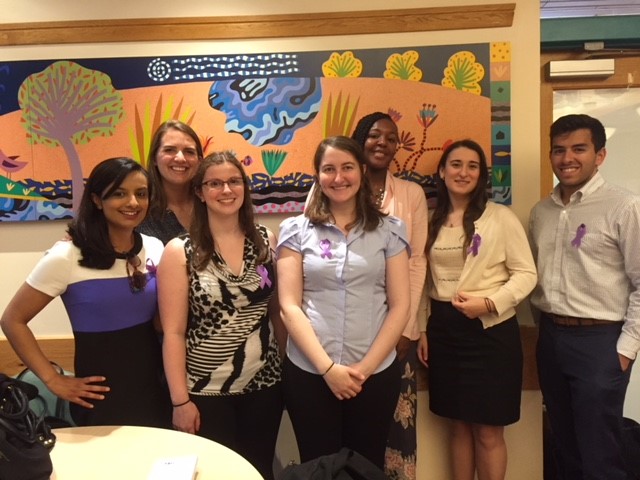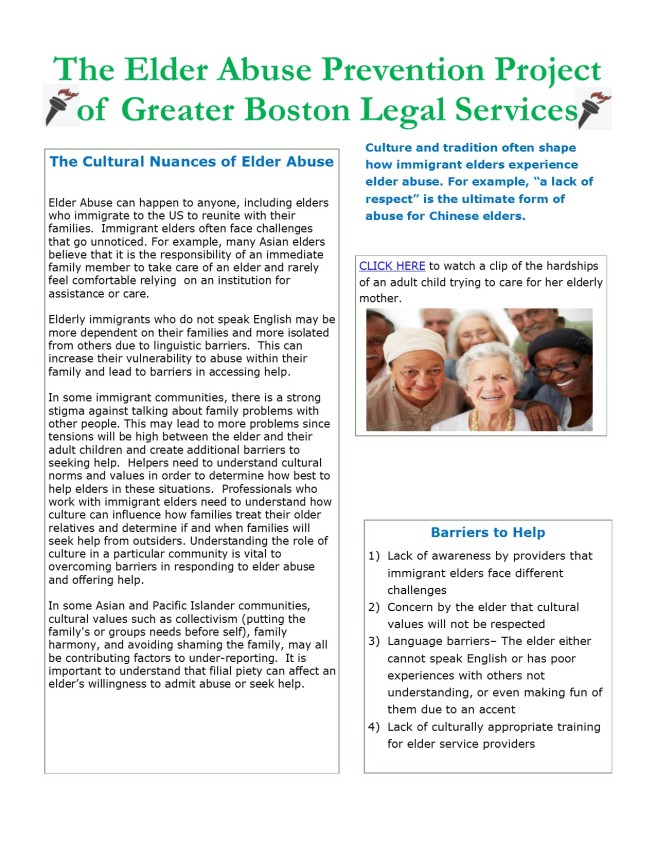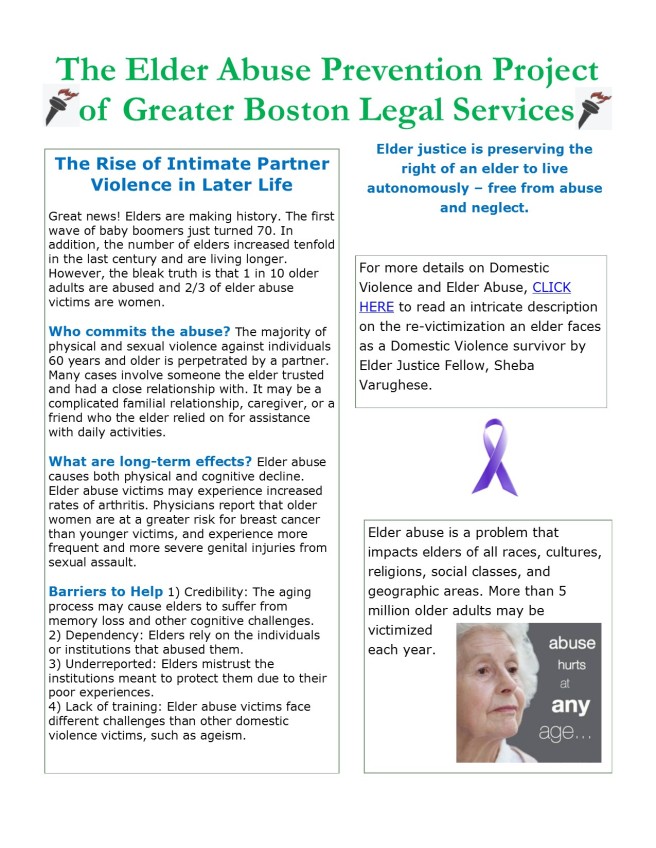Financial abuse is the improper or unauthorized use of money, assets, or property. Elders are susceptible to financial abuse due to a variety of factors, such as physical and mental disabilities, language barriers, memory loss, or failure to fully comprehend complex financial matters. Financial abuse occurs by the misuse of power by a single individual or an institution (nursing homes, financial establishments, or governmental authorities).
the improper or unauthorized use of money, assets, or property. Elders are susceptible to financial abuse due to a variety of factors, such as physical and mental disabilities, language barriers, memory loss, or failure to fully comprehend complex financial matters. Financial abuse occurs by the misuse of power by a single individual or an institution (nursing homes, financial establishments, or governmental authorities).
The Social Security Administration (SSA) is the primary governmental institution that elders must interact with to receive cash benefits, along with healthcare benefits through the Medicare program. Many elders rely on SSA benefits for their basic necessities of food, shelter, and clothing. This article will examine the hurdles elders must jump over to access the local SSA offices.
Casework
Recently, I conducted an appeal before an Administrative Law Judge at the Social Security Office in Boston because my client, “Maya Jones” was notified that her SSI benefits were being terminated, and that she owed Social Security over $10,000. Unfortunately, the issue of overpayment is a recurring issue, and not unique to Maya. The SSA often overpays large sums of money to beneficiaries — and lawyers, consumer advocates and watchdogs agree that the agency’s own missteps are to blame.[1] The worst part is that the SSA then goes after low-income elders to pay back the money the SSA mistakenly released.
Maya is a 71-year-old woman who lives alone, and relies on SSI benefits to survive. Through my investigation, I learned that Maya received SSI benefits due to her low-income and age. Additionally, she received widow’s benefits. Maya suffers from anxiety and depression and is also the caretaker of her daughter, who suffers from an intellectual disability and receives services from the Department of Developmental Services (DDS). Once Maya received the notices of termination and overpayment from SSA, she contacted our office. Due to the termination, Maya was unable to pay her monthly living expenses and important bills to provide for herself and her daughter.
Maya purchased life insurance policies from a life insurance agent who was selling policies door-to-door in her housing development. The agent manipulated and financially exploited her through means of harassment and fear. The agent knocked on her door on several occasions and he tricked Maya into believing that it was necessary to purchase five life insurance policies for financial security for the future of her daughter.
Unfortunately, the five policies put Maya over the resource limit for SSI benefits, which is a mere $2,000 a month.[2] A life insurance policy is a contract that has a cash surrender value, meaning a policy owner may cancel the policy and obtain its monetary value. Maya did not report the changes in her assets to Social Security because she did not know that life insurance policies include a cash surrender value, or comprehend that taking out five policies would affect her SSI benefits or eligibility. Instead of treating Maya as the victim of a scammer, and looking at the totality of her circumstances as SSA is required to do, SSA just cut off her only source of income, thus victimizing her again.
Additionally, I represent a married couple, “John and Mary Jane Smith”. Both are elders; both have physical disabilities prohibiting their ability to work; both have cognitive challenges; both are illiterate. They do not have children, or identified immediate family that is alive and able to support them. At the time I met them, they were living off John’s retirement benefits, which was a little over $1,000.
However, the SSA created obstacles for Mary Jane in several ways, through what should have been a painless process of applying for spousal benefits. First, the SSA did not accommodate Mary Jane’s physical disabilities. They requested that she walk through the security gate without her cane, which she was unable to do. Second, she was forced to stand because of the overcrowded room. Third, the wait time at the SSA office is often excessive, resulting in a minimum of 2 hours. Food and drinks are not allowed, and the agents are behind bulletproof windows, which creates a rather hostile atmosphere. Unfortunately, it is common for one case to require several trips to the local SSA office to resolve issues because of the multilayered issues in a single case.
After multiple trips to Social Security, I learned that Mary Jane was eligible for either: 1) retirement benefits, 2) SSI, or 3) spousal benefits through her husband’s retirement benefits. I assisted Mary Jane in the application process. I determined the highest amount and best option for Mary Jane and John were for her to receive the spousal benefits. Mary Jane’s expected spousal benefits combined with her husband’s retirement check made her ineligible for SSI benefits. Her personal retirement benefits were a low amount because she had insufficient work history due to medical reasons. Mary Jane required a retroactive check to be issued because SSA did not timely disburse her benefits.
Yet, there was another hardship presented by SSA. Their computer showed two different dates of birth due to a typo for Mary Jane, and thus SSA refused to release her spousal benefits until we showed proof of identification. Mary Jane and I made another trip to SSA, and showed them her birth certificate. However, the story does not stop there. SSA lost the copy of the birth certificate, and sent notices to Mary Jane that she would not receive her spousal benefits until this technical error was fixed. I spoke to multiple agents, and showed proof of date stamp that Mary Jane provided them with the original birth certificate. Yet, they were relentless and insisted that Mary Jane travel to the SSA office with the original birth certificate, or they would not process her application. After several advocacy type phone calls, I was able to access a supervisor. He agreed that it was unfair to request Mary Jane reappear, and apologized for the inconvenience. He processed Mary Jane’s paperwork. Almost a month later, SSA released Mary Jane’s spousal benefits.
Recommendations
Millions of elderly and disabled Americans rely upon benefits from the SSA just to meet their monthly expenses. The denial of these benefits can sometimes be arbitrary and the appellate process is often lengthy. The current methods used by the SSA to report changes to assets and appeals process should be reformed. Elders often feel stranded, stressed, and many feel the current system causes more chaos than relief. Demanding that a low-income elder miss work, or spend hours at an office when they suffer from a medical condition is no easy task. It is quite unfair, and adds to the stressful process of applying for or trying to retain benefits.
Therefore, self-assessment is necessary to improve the methods of the SSA, and accommodate the various needs of elders. Employees should be provided materials, attend presentations to detect issues such as memory loss, and learn how to identify and prevent elder abuse, including financial exploitation. The SSA provides modules and other informational materials to educate individuals and organizations about the roles and responsibilities of serving as a representative payee, elder abuse, and financial exploitation, effective ways to monitor and safely conduct business with the banking community, and ways to recognize the changes in decisional capacity among vulnerable adults and seniors.[3] However, the SSA tends to focus on these types of third-party issues and fails to acknowledge its part in creating and causing serious financial heartaches for elders. My casework reveals that the employees at the various SSA offices require this same type of training and supervision to fully understand the complex issues that are often involved in cases of elders such as mental illness; mobility difficulties; hearing or vision loss; or dementia.
The SSA may consider restructure of their staff, by adding a counselor, or some sort of social worker to assist elders in completing forms and navigating the requirements of SSA. This is similar to the ones established by Medicare, known as SHINE Counselors. SHINE Counselors are trained and certified volunteers, who assist elders and individuals with disabilities in understanding their Medicare and MassHealth benefits and other health insurance options.[4] Likewise, SSA may consider training volunteers to facilitate the needs of their office, and produce a smoother process for both financially distressed elders and the local SSA office itself. A counselor will intercede and be mindful to the treatment of the elder during the process of applying for benefits. A counselor is effective to reduce the current adversarial process, and will assist the elder to navigate the office easily. Given our current demographics, over the next several decades, there will be an ever expanding population of elderly SSA recipients who will need assistance navigating a very complex system. Thus, SSA should make every effort to address the needs of this population to ensure that some of our most vulnerable citizens continue to receive the benefits they worked hard to earn or that they need just to survive.
[1] CNN Article http://money.cnn.com/2013/10/29/pf/social-security-overpayments/
[2] 20 C.F.R. § 416.552
[3] https://www.ssa.gov/payee/rp_training2.html
[4] http://www.mass.gov/elders/healthcare/shine/serving-the-health-information-needs-of-elders.html





 Recently, I attended a training on domestic violence and elder abuse hosted by the Transition House and the Cambridge Council on Aging in Cambridge, Massachusetts. We watched a video about an elderly domestic violence survivor, “Mary,” whose husband was physically abusive. Mary attempted to leave the life-threatening situation on more than one occasion. However, due to the failure of various authorities, she was left to fend for herself. The police officers who investigated did not believe her story; rather they scrutinized Mary’s character and inquired, “What she did wrong to instigate the quarrel”. Victim-blaming is a common thread that runs deep with elder abuse victims because of their frequent inability to properly recollect the step-by-step event. Mary’s church officials denied that the violence was occurring due to her spouse’s positive reputation in the community. On one occasion, she was hospitalized because of the severity of the abuse and a social worker disclosed Mary’s whereabouts to her spouse, even though she had a restraining order in effect. The social worker believed Mary was disillusioned due to the nature of her medications and head trauma. Mary is only a survivor now because her spouse committed suicide, and she is no longer subject to his wrath.
Recently, I attended a training on domestic violence and elder abuse hosted by the Transition House and the Cambridge Council on Aging in Cambridge, Massachusetts. We watched a video about an elderly domestic violence survivor, “Mary,” whose husband was physically abusive. Mary attempted to leave the life-threatening situation on more than one occasion. However, due to the failure of various authorities, she was left to fend for herself. The police officers who investigated did not believe her story; rather they scrutinized Mary’s character and inquired, “What she did wrong to instigate the quarrel”. Victim-blaming is a common thread that runs deep with elder abuse victims because of their frequent inability to properly recollect the step-by-step event. Mary’s church officials denied that the violence was occurring due to her spouse’s positive reputation in the community. On one occasion, she was hospitalized because of the severity of the abuse and a social worker disclosed Mary’s whereabouts to her spouse, even though she had a restraining order in effect. The social worker believed Mary was disillusioned due to the nature of her medications and head trauma. Mary is only a survivor now because her spouse committed suicide, and she is no longer subject to his wrath. the improper or unauthorized use of money, assets, or property. Elders are susceptible to financial abuse due to a variety of factors, such as physical and mental disabilities, language barriers, memory loss, or failure to fully comprehend complex financial matters. Financial abuse occurs by the misuse of power by a single individual or an institution (nursing homes, financial establishments, or governmental authorities).
the improper or unauthorized use of money, assets, or property. Elders are susceptible to financial abuse due to a variety of factors, such as physical and mental disabilities, language barriers, memory loss, or failure to fully comprehend complex financial matters. Financial abuse occurs by the misuse of power by a single individual or an institution (nursing homes, financial establishments, or governmental authorities).